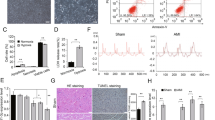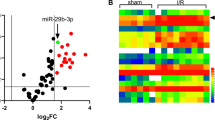Abstract
MicroRNAs participate in the regulation of abnormal cardiomyocyte apoptosis and autophagy, which leads to heart failure (HF). Lower miR-29b-3p levels were found in HF patients in this study. However, the role of miR-29b-3p in the molecular pathogenesis of HF remains unclear. Hypoxia-stimulated H9c2 cells were used an in vitro model of HF. It was found that hypoxia stimulation decreased the miR-29b-3p expression and enhanced cell apoptosis and autophagy response in H9c2 cells. While the effects of hypoxia on cell apoptosis and autophagy were reversed by miR-29b-3p transfection, especially 100 nM. The secreted protein acidic and rich in cysteine (SPARC), predicted as a direct target of miR-29b-3p, aggravated the hypoxia-induced cells apoptosis, autophagy, and TGFβ1/Smad3 activation. While the changes were dramatically reversed by miR-29b-3p. Taken together, our data suggest that miR-29b-3p plays an important role in the progression of HF through targeting SPARC and regulating TGFβ1/Smad3 pathway.





Similar content being viewed by others
References
Brito D., Cepeda B. (2017) Heart failure, congestive (CHF).
Jose Corbalan, J., Vatner, D. E., & Vatner, S. F. (2016). Myocardial apoptosis in heart disease: does the emperor have clothes? Basic Research in Cardiology, 111(3), 31.
Xia, P., Liu, Y., & Cheng, Z. (2016). Signaling pathways in cardiac myocyte apoptosis. BioMed Research International, 2016, 9583268.
Gustafsson, A. B., & Gottlieb, R. A. (2009). Autophagy in ischemic heart disease. Circulation Research, 104(2), 150–158.
Mialet-Perez, J., & Vindis, C. (2017). Autophagy in health and disease: focus on the cardiovascular system. Essays in Biochemistry, 61(6), 721–732.
Wong, L. L., Rademaker, M. T., Saw, E. L., Lew, K. S., Ellmers, L. J., Charles, C. J., Richards, A. M., & Wang, P. (2017). Identification of novel microRNAs in the sheep heart and their regulation in heart failure. Scientific Reports, 7(1), 8250.
Tijsen, A. J., Pinto, Y. M., & Creemers, E. E. (2012). Non-cardiomyocyte microRNAs in heart failure. Cardiovascular Research, 93(4), 573–582.
Mendell, J. T., & Olson, E. N. (2012). MicroRNAs in stress signaling and human disease. Cell, 148(6), 1172–1187.
Zhu, M. L., Yin, Y. L., Ping, S., Yu, H. Y., Wan, G. R., Jian, X., & Li, P. (2017). Berberine promotes ischemia-induced angiogenesis in mice heart via upregulation of microRNA-29b. Clinical and Experimental Hypertension, 39(7), 672–679.
Yang, F., Li, P., Li, H., Shi, Q., Li, S., & Zhao, L. (2015). microRNA-29b mediates the antifibrotic effect of Tanshinone IIA in postinfarct cardiac remodeling. Journal of Cardiovascular Pharmacology, 65(5), 456–464.
Abonnenc, M., Nabeebaccus, A. A., Mayr, U., Barallobre-Barreiro, J., Dong, X., Cuello, F., Sur, S., Drozdov, I., Langley, S. R., Lu, R., et al. (2013). Extracellular matrix secretion by cardiac fibroblasts: role of microRNA-29b and microRNA-30c. Circulation Research, 113(10), 1138–1147.
Marques, F. Z., Vizi, D., Khammy, O., Mariani, J. A., & Kaye, D. M. (2016). The transcardiac gradient of cardio-microRNAs in the failing heart. European Journal of Heart Failure, 18(8), 1000–1008.
Yang, Y. F., Wu, C. C., Chen, W. P., & Su, M. J. (2009). Transforming growth factor-beta type I receptor/ALK5 contributes to doxazosin-induced apoptosis in H9C2 cells. Naunyn-Schmiedeberg’s Archives of Pharmacology, 380(6), 561–567.
Ghavami, S., Cunnington, R. H., Gupta, S., Yeganeh, B., Filomeno, K. L., Freed, D. H., Chen, S., Klonisch, T., Halayko, A. J., Ambrose, E., et al. (2015). Autophagy is a regulator of TGF-beta1-induced fibrogenesis in primary human atrial myofibroblasts. Cell Death & Disease, 6, e1696.
Chen, K., Chen, W., Liu, S. L., Wu, T. S., Yu, K. F., Qi, J., Wang, Y., Yao, H., Huang, X. Y., Han, Y., et al. (2018). Epigallocatechingallate attenuates myocardial injury in a mouse model of heart failure through TGFbeta1/Smad3 signaling pathway. Molecular Medicine Reports, 17(6), 7652–7660.
Pandey, A. C., Lancaster, J. J., Harris, D. T., Goldman, S., & Juneman, E. (2017). Cellular therapeutics for heart failure: focus on mesenchymal stem cells. Stem Cells International, 2017, 9640108.
Hashimoto, H., Olson, E. N., & Bassel-Duby, R. (2018). Therapeutic approaches for cardiac regeneration and repair. Nature Reviews. Cardiology.
Zhang, J., Liu, D., Zhang, M., & Zhang, Y. (2018). Cardiomyocyte programmed necrosis: mitochondria, death receptor and beyond. Br J Pharmacol.
Moon, S. H., Bae, D., Jung, T. H., Chung, E. B., Jeong, Y. H., Park, S. J., & Chung, H. M. (2017). From bench to market: preparing human pluripotent stem cells derived cardiomyocytes for various applications. Int J Stem Cells, 10(1), 1–11.
Huang, Z., Ye, B., Dai, Z., Wu, X., Lu, Z., Shan, P., & Huang, W. (2015). Curcumin inhibits autophagy and apoptosis in hypoxia/reoxygenation-induced myocytes. Molecular Medicine Reports, 11(6), 4678–4684.
Qin, L., Fan, S., Jia, R., & Liu, Y. (2018). Ginsenoside Rg1 protects cardiomyocytes from hypoxia-induced injury through the PI3K/AKT/mTOR pathway. Pharmazie, 73(6), 349–355.
Roohbakhsh, A., Shamsizadeh, A., Hayes, A. W., Reiter, R. J., & Karimi, G. (2018). Melatonin as an endogenous regulator of diseases: the role of autophagy. Pharmacological Research.
Kriegel, A. J., Liu, Y., Fang, Y., Ding, X., & Liang, M. (2012). The miR-29 family: genomics, cell biology, and relevance to renal and cardiovascular injury. Physiological Genomics, 44(4), 237–244.
Ye, Y., Hu, Z., Lin, Y., Zhang, C., & Perez-Polo, J. R. (2010). Downregulation of microRNA-29 by antisense inhibitors and a PPAR-gamma agonist protects against myocardial ischaemia-reperfusion injury. Cardiovascular Research, 87(3), 535–544.
Zhang, J., He, Z., Xiao, W., Na, Q., Wu, T., Su, K., & Cui, X. (2016). Overexpression of BAG3 attenuates hypoxia-induced cardiomyocyte apoptosis by inducing autophagy. Cellular Physiology and Biochemistry, 39(2), 491–500.
Mehrhof, F. B., Muller, F. U., Bergmann, M. W., Li, P., Wang, Y., Schmitz, W., Dietz, R., & von Harsdorf, R. (2001). In cardiomyocyte hypoxia, insulin-like growth factor-I-induced antiapoptotic signaling requires phosphatidylinositol-3-OH-kinase-dependent and mitogen-activated protein kinase-dependent activation of the transcription factor cAMP response element-binding protein. Circulation, 104(17), 2088–2094.
Hu, Z., Cai, H. Y., Luo, Y. Y., Xiao, J. M., Li, L., & Guo, T. (2018). Effect of varying hypoxia reoxygenation times on autophagy of cardiomyocytes. Acta Cirúrgica Brasileira, 33(3), 223–230.
Harris, B. S., Zhang, Y., Card, L., Rivera, L. B., Brekken, R. A., & Bradshaw, A. D. (2011). SPARC regulates collagen interaction with cardiac fibroblast cell surfaces. American Journal of Physiology. Heart and Circulatory Physiology, 301(3), H841–H847.
Hartley, P. S., Motamedchaboki, K., Bodmer, R., & Ocorr, K. (2016). SPARC-dependent cardiomyopathy in drosophila. Circulation. Cardiovascular Genetics, 9(2), 119–129.
Lindsey, M. L., Mann, D. L., Entman, M. L., & Spinale, F. G. (2003). Extracellular matrix remodeling following myocardial injury. Annals of Medicine, 35(5), 316–326.
Wang, Y., Wang, Q., Zhang, L., Ke, Z., Zhao, Y., Wang, D., Chen, H., Jiang, X., Gu, M., Fan, S., et al. (2017). Coptisine protects cardiomyocyte against hypoxia/reoxygenation-induced damage via inhibition of autophagy. Biochemical and Biophysical Research Communications, 490(2), 231–238.
Acknowledgements
The authors would like to thank the members of the Second Department of Cardiology, Xinxiang Central Hospital for participating and providing blood samples in this study.
Author information
Authors and Affiliations
Corresponding author
Ethics declarations
Conflict of Interest
The author declares that they have no conflicts of interest.
Human Subjects/Informed Consent Statement
The present study was approved by the Ethics Committee of Xinxiang Central Hospital, and written informed consent was obtained from the patients and healthy donors.
Animal Studies
No animal studies were carried out by the authors for this article.
Additional information
Associate Editor Joost Sluijter oversaw the review of this article
Publisher’s Note
Springer Nature remains neutral with regard to jurisdictional claims in published maps and institutional affiliations.
Rights and permissions
About this article
Cite this article
Zhou, S., Lei, D., Bu, F. et al. MicroRNA-29b-3p Targets SPARC Gene to Protect Cardiocytes against Autophagy and Apoptosis in Hypoxic-Induced H9c2 Cells. J. of Cardiovasc. Trans. Res. 12, 358–365 (2019). https://doi.org/10.1007/s12265-018-9858-1
Received:
Accepted:
Published:
Issue Date:
DOI: https://doi.org/10.1007/s12265-018-9858-1




